|
Historic Memphis
Buildings |
|
... and notable Businesses |
|
|
|
|
|
 |
During the late 1960s and 1970s much of downtown Memphis was
allowed to fall into a downward spiral. After the Martin
Luther King assassination in 1968, the city deteriorated
further into desolate, abandoned storefronts on desolate
abandoned streets, as citizens and businesses fled the
downtown area. Buildings were boarded up and left to
die. Many historical buildings were demolished - only to be
replaced by parking lots. Eventually the
preservationists came out in the 1980s. It was almost
too late. The renovation and reopening of the
Peabody Hotel in 1981 marked the beginning of true
revitalization - which is still a work in process. Now
Memphis appears to be turning around and many of the notable
buildings have been renovated as apartment buildings.
People are actually moving in and businesses are returning to
downtown. But downtown is still a hodgepodge of the old
and the new separated by empty lots. |
|
|
|
This page
pays homage to many of the city's fine historic buildings. Some,
like the theatres, churches, and department stores, have been covered on
separate pages of this website. In many cases, a notable business is
associated with a particular building and those will also be covered
here.
What makes a building historic? In a city that's
not especially known for appreciating its past, simply surviving the
demolition crew would seem to be the number one criteria. In
addition they must be largely unaltered, be associated with famous
people or events, be the work of notable architects or craftsmen, be
of a particular architectural style or have archeological value.
We were surprised to learn that Memphis is the #6 City in the nation
for listings of properties on the National Register of Historic
Places - behind Washington DC, Baltimore, Philadelphia, Boston, and New Orleans.
We were even more surprised to learn that almost all the buildings
on this page are still around - although not necessarily thriving,
or completely out of danger. |
|
|
|
|
Click on small
photos to see large photos: There are MANY photos.
Please wait two minutes to load before clicking. |
|
|
|
|
|
|
Armory Building .
2525 Central Av. |
|
|
 |
The
old Armory Building was built in 1942 and was home to the
Tennessee National Guard. The concrete Art Deco building
was designed by Walk C. Jones and was considered the finest
armory in Tennessee. In 1946 it became home to the famous
bomber, The Memphis Belle, which was on display in front of the
building, exposed to the elements and anyone who wanted a
souvenir. By the time the city moved her to Mud Island
there wasn't much left and virtually no one was interested in
contributing to renovation. The U. S. Air Force took her
back for eventual display at their museum in Dayton, Ohio.
By the 1970's the Armory Building has outlived its usefulness
and as usual there was talk of demolition. The Children's
Museum came to the rescue and now leases the building for $1 a
year. |
|
|
|
 |
 |
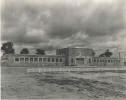 |
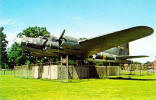 |
 |
| Under
construction |
Under
construction |
Building
Opens |
The Memphis
Belle |
Children's
Museum |
|
|
|
|
|
|
|
Ballard and Ballard Obelisk Flour Building .
325 Wagner Pl |
| |
 |
The
Ballard and Ballard building dates from 1924. Fittingly,
it was designed in the Egyptian Revival style - one of the few
buildings in Memphis with Egyptian motifs. Located in an
industrial area this is one of the more interesting buildings in
the city. The Ballard and
Ballard building was added to the National Register in 1999.
The building still stands. It is currently owned by Jerry and
Kitty Sansing and houses H & S Printing. Part of the
building facing the Mississippi at Number 2 Vance is an Events
Venue. |
|
| |
 |
 |
 |
 |
 |
|
Ballard-Ballard |
Ballard-Details |
Ballard-Details |
Ballard - Details |
Ballard-Details |
|
| |
|
|
| |
| |
|
| |
| |
| Brodnax
Building . 20 S. Main |
| |
|
The Brodnax Building dates from 1915 and was built by George T.
Brodnax, Inc . The company was founded in 1897 and was
considered the premiere jewelery store in Memphis. The
classically designed building has been beautifully restored. |
| |
 |
 |
 |
 |
 |
|
Brodnax
Building |
Brodnax
Today |
1910 Catalog |
1917 Ad |
1910 Catalog |
|
|
|
 |
 |
 |
 |
 |
|
Brodnax
Interior 1940 |
Brodnax
interior 1909 |
G. T. Broadnax |
G. T. Broadnax |
Brodnax
Ad 1905 |
|
|
|
 |
 |
 |
 |
 |
 |
| Trinket-Holder |
1915 Catalog |
Spoon |
Ad 1910 |
Broadnax
marker |
1945 Receipt |
|
|
|
|
|
|
|
|
|
|
|
Business Men's Club . Chamber of Commerce
. 81 Monroe |
|
|
The
Memphis Business Men's Club was founded in 1899. Their purpose
was simply to promote the interests of Memphis. Their building
was designed by Shaw and Pfeil in 1910 and inspired by the designs
of architect Louis Sullivan. In 1913 the Business Men's Club
changed their name to the Memphis Chamber of Commerce.
In 1980 the building was converted to office space. The
Chamber of Commerce has now moved to the Falls Building on Front Street.
|
 |
| |
|
|
The various names of the Chamber of Commerce since 1838:
Memphis Businessmen’s Club (1838)
. Memphis Businessmen's Club Chamber of Commerce (1916) .
Memphis Chamber of Commerce (1917) . Memphis Area Chamber of
Commerce (1975) . The Chamber – Memphis Area Chamber of
Commerce (1982) . Memphis Regional Chamber of Commerce
(2002) .
Greater Memphis Chamber (2007). |
| |
|
 |
 |
 |
 |
 |
 |
|
1937 |
Building
today |
1912 |
Pool Room |
"For
Memphis" 1930s |
|
|
|
|
|
|
|
|
|
|
|
|
|
|
|
Central Bank &
Trust Building .
Goodwyn
Building
.
121 - 127
Madison |
|
|
 |
The 18-Story Central Bank and Trust was built in 1911-12 and
designed by James Gamble Rogers, who also designed Brooks Memorial
Art Museum and the Shelby County Courthouse. The building has
been renovated into condos and is now named The Goodwyn Building. |
|
|
|
|
|
|
|
|
|
|
|
|
|
|
|
Central Police
Station .
130 Adams |
|
|
|
Built in 1911 in a neo-classical style reminiscent of the
nearby Shelby County Courthouse. The structure was
built on the site of an older police headquarters buildings.
There was a rock pile behind the previous station where
offenders worked making small rocks out of big rocks.
The building has recently been renovated. |
|
|
|
|
|
|
|
|
|
|
|
|
Churches
* |
|
|
|
|
|
|
|
*
Memphis churches have
their own comprehensive coverage on another section of this
website >
Click here |
|
|
|
|
|
|
|
|
|
|
Columbian Mutual Tower .
Lincoln American Tower
.
60 N. Main |
| |
 |
 |
 |
The Columbian Mutual Tower was built in 1924 by notorious Memphis
censor Lloyd T. Binford as a 1/3 version of
New York City's Woolworth Building. The style might be
referred to as Late Gothic Revival. It had a steel frame
enclosed in concrete, covered by terra cotta. The building was
the home of
Columbian Mutual Insurance, which is now called Lincoln American
Insurance. The building's name has also been changed to
"Lincoln American Tower". It's now a mixed-use
building with offices and apartments. |
|
Postcard |
Columbian |
Construction |
|
|
|
|
|
|
|
|
|
|
|
|
|
|
Commerce Title Building.
10 S. Main |
|
|
 |
This building was developed in stages. In 1904 the
southern half of the neo-classic structure was built
originally as the Memphis Trust Company Building. 10
years later, the north half was added as a mirror image of the
southern half. The vertical seam where the two sections
meet is clearly visible. Today the building contains
over 150 apartment homes. |
|
|
|
| |
|
|
 |
 |
| |
|
|
Today |
Today |
|
|
|
|
|
|
|
|
|
|
|
Commerce &
Trust Bank .
45 S.
Second |
|
|
The Neo-Classical Revival Style Bank of Commerce & Trust was built in
1929. The building has now been renovated and in 1980 was
added to the National Historic Places list. |
 |
|
|
|
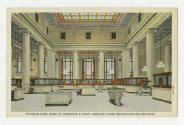 |
 |
 |
 |
 |
|
Interior |
Knife |
Today |
Today |
Today |
|
|
|
|
|
|
|
|
|
|
|
Commercial
Appeal .
Bank of Tennessee . Welcome
Wagon . 30 N. 2nd |
|
|
|
Built in 1907, this structure housed the Commercial Appeal
from 1907 to 1933. It featured a famous electronic sign
that kept Memphians up to date with the latest headlines.
WMC, one of Memphis' first commercial radio stations, was
established on the top floor of the building in 1923 .
The Commercial Appeal moved to a new location in 1933, and the
building became headquarters for the Welcome Wagon
organization, which was founded in Memphis in 1928. |
|
|
 |
 |
 |
 |
 |
|
Welcome Wagon
|
2012 |
2012 |
Flag Sign |
Flag Sign-night |
|
|
|
|
|
|
|
|
|
Cossitt
Library
*
One of the two most
beautiful and distinctive buildings the city ever had. |
|
|
|
|
|
*
Cossitt Library has its own comprehensive coverage on another section of this
website >
Click here |
|
|
|
|
|
|
|
|
|
|
Cotton Exchange
(Old-New)
.
Front, NW corner Madison
.
9 N Second at Court .
65 Union at Front |
|
|
|
The
current Cotton Exchange building is located just one block from the Mississippi River
on Memphis' Cotton Row. The old Cotton Exchange building was built in
1883-85 and was located at Court and 2nd. The architect was Mathias Harvey Baldwin who had
previously built the great Lowenstein Building. It was
immediately considered a great commercial structure with its
classically detailed facade that was very complex. The
interplay of curves and triangles gave an imposing look to the
building.
What
is not commonly known is that when this building opened
in 1885, it had "Dual Names" - The Cotton and Merchants
Exchange Building. The Merchants Exchange was an early version
of the Chamber of Commerce.
|
 |
|
|
|
|
The
beautiful old Cotton Exchange building was demolished in 1910 to
make way for the new skyscraper Exchange Building, where the Cotton
Exchange would occupy space until their new Cotton Exchange Building
was built in 1924-25 at the corner of Union and Front.
Today the Union-Front building has been renovated and the Memphis
Cotton Museum occupies the lower floor and apartments occupy the
upper floors. |
 |
 |
 |
 |
 |
|
Old
Cotton Exchange |
Cotton
Exchange from North |
Interiors - 1903 |
Old
and New Cotton Exchange Bldgs |
|
|
 |
 |
 |
 |
 |
 |
|
Opening
day - 1890 |
1882
Letter |
1885
Drawing |
Postcard |
1895
Photo |
Rare
Photo |
|
|
|
|
A
recent discovery indicates there was an earlier Cotton Exchange
on Front-NW Corner of Madison. It has been verified at
that location from 1874-84, and then it moved into the newly
erected building at 2nd and Court. We discovered this in a
drawing on an old 1876 Map of Memphis. We recognized the
drawing as a prominent building and found a 1920s photo of it. |
 |
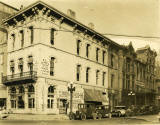 |
 |
| |
1876 Drawing |
1920s photo |
1874
|
|
|
|
|
This extremely rare set of illustrations
(below) was printed in 1885 as
a souvenir to celebrate the opening of the Cotton-Merchants
Exchange Building. The illustrations were tied together
with ribbons and were meant to be hung vertically on a wall as
decoration (See #1). When folded they could have been sent
by mail. This predated the actual postcard by quite a few
years.
- Collection of the Janet Hendricks Harden Family |
|
|
|
|
 |
<
=
This is the actual 1885 newspaper coverage of the opening of the
Cotton Merchant's Exchange.
|
| 1885
article |
|
|
|
|
|
| |
| |
|
| |
| |
|
Crump Building
.
110 Adams |
|
|
 |
 |
 |
Built in 1901, this was the North Memphis Savings Bank.
But in 1920 it became the home of the E. H. Crump Insurance
Company and it was here that "Boss" Crump controlled the city
and state through his political machine. The building is
currently home to the Center City Commission, now known as the
Downtown Memphis Commission. They also hold title to the
building. |
|
|
|
|
|
|
|
|
|
|
|
Customs House -
Courthouse - Post Office - UM School of
Law .
1
S. Front Street |
|
|
 |
 |

 |
 |
 |
|
Customs
House |
SSouvenir
Vase 1900 |
Souvenirs |
Miniature Model |
Souvenir
Cup |
|
|
 |
The
original building was built in 1876 as The Customs House. It
was one of the proudest structures in the city, with two large
matching towers that stood out in the city's skyline from the river.
This was a grand building. But in 1929 it was greatly enlarged
when it became a post office. Both towers were removed and
wings were added at the north and south ends. The entire
building received a new outer wall of granite. Not that this
building was bad, it simply wasn't as notable as the old building.
In 2010, the building was totally renovated and became the
University of Memphis, School of Law. |
|
|
|
|
|
|
|
|
|
|
|
|
|
|
Department
Stores
* |
|
|
|
|
|
*
Department Stores have
their own comprehensive coverage on another section of this
website >
Click here |
|
|
|
|
|
|
|
|
|
|
Dermon Building
.
46 N. Third
|
|
|
|
The Dermon
Building was constructed in 1925 as a home for the Dave Dermon
Company and Dave Dermon Insurance. It was designed by Charles Pfeil and George Awsumb. Although the building was sold in the
1930s and has changed owners frequently, it is still known as the
Dermon Building - something rare in Memphis. It's an
impressive 10 story structure of dark brown brick with Renaissance
details in yellow, green, and white terra cotta. The front and
side facades are much richer in ornamentation than the rear.
After the more elaborate Kress Building, the Dermon Building
exhibits the most colorful use of glazed architectural terra cotta
in Memphis. The Dermon was added to the National Register in
1984. |
 |
| |
|
|
|
|
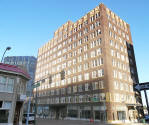 |
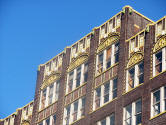 |
 |
 |
 |
|
Dermon Building |
Details |
Details |
Details |
Details |
|
|
|
|
|
|
|
|
|
|
|
Drug Stores
and Drug Supply Houses
* |
|
|
|
|
|
|
|
*
Drug Stores and Drug
Supply Houses are covered on another section of this website >
Click here |
|
|
|
|
|
|
|
|
|
|
Elks Building
.
69-71
Jefferson
|
|
|
|
This
building dates from at least 1905 - a date that is verified with a
listing in the Memphis Directories. The structure remained the
home of the Elks until 1926, when it was demolished - along with the
entire block, to make room for the 12 story Elks Club
Building-Hotel. This new building became the Hotel DeVoy and
later the better known Hotel King Cotton. The DeVoy and
the Hotel King Cotton are both covered on the "Hotel" section of
this website. |
|
. |
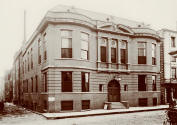 |
 |
 |
 |
|
Elks Club 1926 |
Elks Club 1906 |
Elks Club Interior |
Elks Club Hotel |
|
|
|
|
|
|
|
|
|
Exchange Building
.
9 N. Second
Street |
|
|
|
|
|
The 19 story Exchange Building was built in 1910 and for 20
years was the tallest building in Memphis, until surpassed by the Columbia Mutual Tower. It was designed
by Neander Montgomery Woods in the Beaux Arts style.
The Memphis Cotton Exchange had space here until moving to their own
building at Front and Union in 1923. For many
years it was home to dentists, lawyers, and small businesses.
In 1995, the Exchange Building was renovated and is today
apartments. The building was added to the National
Register in 1979.
The Exchange Building was built on the site of the beautiful
old Memphis Cotton Exchange Building. We've not been
able to verify it, but it appears that the architect either
incorporated the old lower floor design into the new building
or built the new skyscraper on top of the lower floor of the
old building. |
|
 |
|
Exchange
1911 |
|
|
|
|
 |
|
Rare
View |
|
|
|
|
|
|
|
|
|
|
|
|
|
|
Equitable
Building .
Appeal Building .
Bry's . Lowenstein's
.
99 N. Main at
Jefferson. |
|
|
|
The
Equitable Building, which was located on the corner of Main and
Jefferson, dates back to 1889-1890. This have been verified
with listings in the Memphis Directories. The structure was built primarily as an
office building and it housed the old Appeal Newspaper and for a few
years became known as the "Appeal Building". When Bry's
Department Store bought the building in the early 1900s, it was
updated and the roof
architectural accents were removed. They eventually almost
doubled the size of the building by enlarging the building next
door. Lowenstein's purchased Bry's in 1956. Bry's closed
in 1962 or 64 and Lowenstein's demolished the building and built
Lowenstein's Tower at 99 N. Main, in 1969.
Lowenstein's closed and liquidated in 1981.
The Renaissance Apartments tower and its parking garage occupy this
site today. |
|
|
 |
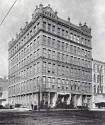 |
 |
 |
 |
 |
|
Equitable Bldg 1904 |
Equitable - Vintage |
Equitable Ad 1899 |
Equitable Card 1907 |
Vintage Card |
Bry's 1918 |
|
|
|
|
|
|
|
|
|
Falls Building
.
20 - 22 North
Front St |
|
|
|
Featuring extra wide windows, the Falls Building was designed
especially for cotton merchants. It was built in 1902
and there was a nightclub called The Alaskan Roof Garden,
because of the cool breeze on the roof. This became
Memphis' premier nightclub and W. C. Handy was the featured
bandleader. He introduced one of his most famous
compositions, "St. Louis Blues" here in 1914. In
addition a group made the city's first radio transmission from
the roof in 1913. Today, the building is home to the
Memphis Chamber of Commerce - now known as "Greater Memphis
Chamber". |
|
|
|
|
|
|
|
|
|
|
|
Farnsworth
Bldg . Three Sisters
Bldg . Business Journal
.
69 S. Main at
Union |
|
 |
The 14
story Farnsworth Building at Main and Union is a notable Art
Deco mid-rise co-designed by William Van Powell in 1927.
Powell went on to design Fairview Junior High - another Art Deco
masterpiece. Decorative detailing will become the
signature of Powell's work. In 1938 a ladies clothing
store named "The Three Sisters" moved here and stayed a
very long
time. By the 1950s Three Sisters expanded and took over
the bottom 6 floors of the building and by then the building
even became known as the Three Sisters
Building. Much later the Business Journal took over
the building and added their sign on top. They have since
moved to Brinkley Plaza,, but their sign has remained. The
building was added to the National Register in 1983. |
|
|
|
 |
 |
 |
 |
 |
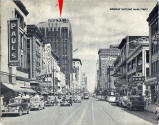 |
|
Farnsworth |
Elevators |
Elevator Door |
Ceiling Detail |
Three Sisters 1950 |
Three
Sisters-Farnsworth |
|
|
|
|
|
|
|
|
|
|
|
Fire Station
Number One
.
118 Adams |
|
|
 |
 |
Fire
Station Number One was built in 1910 and is located next door
to the Central Police Station. Both buildings show
"Boss" Crump's intention to elevate the status of these
departments and to build inspiring public buildings.
Today Station Number One has been renovated and houses the
Fire Museum which contains numerous exhibits on fire safety
and the history of firefighting in Memphis. |
|
|
|
|
|
|
|
|
|
|
|
Gallina
Exchange Building .
Silky
O'Sullivans
.
179-183 Beale
Street |
|
|
|
Judge Charles Gallina built the structure in 1891.
Designed by B. C. Alsup, it was known as the Pride of Beale
Street, housing a bustling saloon which was open 24-7, and a
hotel favored by the Orpheum Theatre crowd. Every room
had a marble fireplace. Judge Gallina lived on the top
floor and held court on the 2nd. After he died in 1914,
the building was a pharmacy, clothing store, and dentist's
office. The steel girders were added in 1980 as a
temporary measure after fire gutted the interior. They
are now an "art piece" and are probably permanent. |
 |
 |
| |
Before the
fire. |
Gallina
Today |
|
|
|
|
|
|
|
|
|
|
|
Goodwyn
Institute Building
* .
165 Madison |
|
|
|
William Goodwyn was a successful Memphis cotton merchant. He
bequeathed his entire fortune for a public library and an
annual series of educational lectures. The Goodwyn Institute
opened in 1907 and the beautiful 7-story Beaux-Arts building
was notable for four large columns above the entrance and for
lions heads in terra-cotta. The top floor held the library and
the third floor was taken up by a 900 seat auditorium. It was
a grand building. The building was demolished in 1962 to
make way for a bank. |
|
|
 |
 |
 |
 |
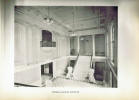 |
 |
|
Goodwyn |
Construction |
Goodwyn |
Post Card |
Goodwyn
- Interior |
Goodwyn
- Library |
|
|
|
|
*
More information and
photos will be found on the MOVIE-LEGITIMATE THEATRE page of the
website. |
|
|
|
|
|
|
|
|
Green Beetle
Tavern .
327 South Main |
|
|
|
This Beaux Arts-style building was built before 1910. It
has ornate stone window arches and a decorative pressed metal
cornice. The building has been occupied by the Green
Beetle Tavern since 1939. It was a popular
speakeasy during Prohibition. Legend has it that panels
in the bar cover bullet holes in the wall made by Machine Gun
Kelly - a native of Memphis. |
 |
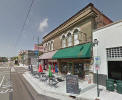 |
|
|
|
|
|
|
|
|
|
|
|
Hart Building
.
48 S. Front |
|
|
|
For
many years this was one of the most impressive buildings on
"Cotton Row". It was designed by B. C. Alsup, built in
1899, and housed the cotton offices of Fulton & Sons. This
building bears a strong resemblance to Beale Street's Gallina
Building which was also designed by Alsup. |
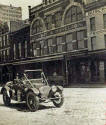 |
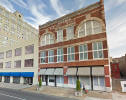 |
|
|
|
|
|
|
|
|
|
|
|
Haverty Building
.
Haverty's Furniture
.
157 S. Main
Street |
|
|
|
For many
years, the Memphis building was associated with Haverty's Furniture.
Haverty's was founded in 1885 in Atalnta, and the business expanded
in 1889 and went into partnership with Rhodes, a partnership that
would be dissolved and then re-instated several times over the next
10 years. The Havety Building, in Richardson Romanesque style,
was built in Memphis in 1891 during one of their expansions.
It was listed on the National Register in 1980. It has now
been renovated. Haverty's Furniture is still in
business. |
|
|
 |
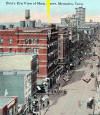 |
 |
 |
 |
 |
| Haverty's
1951 |
Haverty's |
Haverty's
1912 |
Haverty's |
Haverty's |
Haverty's |
|
|
|
 |
 |
 |
 |
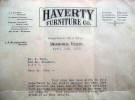 |
|
Haverty's |
Jewel Box |
Building Today |
Building Today |
1923 Billhead |
|
|
|
|
|
|
|
|
|
Helen of
Memphis
.
1808-18 Union Avenue at
Idlewild |
|
|
|
Helen of Memphis was a landmark on Union Avenue for over 50
years and was considered the finest women's clothing store in
Memphis. The building was a wonderful old Gothic Revival
structure built in the early 1900s. The first Helen shop
was opened by Helen Quinn at 1648 Union and sold antiques.
She soon purchased the property at 1808 Union in 1937 and
named it "The Helen Shop" and started selling women's
clothing. It was later expanded and became "Helen of
Memphis". The business became THE shop for the
fashionable women of Memphis. By 1945 Helen was no
longer actively involved but the business continued to
flourish. In 1988 the store closed and the building was
demolished to erect a Rite-Aid pharmacy on the site. |
|
 |
|
A HELEN sign
|
|
|
|
|
 |
 |
 |
 |
 |
 |
|
The Helen Shop |
Helen of Memphis |
Cashmere-Mink |
Jacket |
1979 Ad |
Close up of a Hat Box |
|
|
|
|
EMAIL:
"The
building that eventually became the Helen of Memphis shop was the
former home of St. Luke's Episcopal Church, founded in 1894, which
built its first church home at Union and Idlewild in the early 1900s
before it moved to a new location in 1912 at Peabody and LeMaster...When
the Helen of Memphis shop was still open, you could walk inside and
look up and see remnants of the old church structure."
- Skip Howard, Church Archivist, First Baptist Church of Memphis,
3-23-2013 |
|
|
|
|
|
|
|
|
Homes
* |
|
|
|
|
|
*
Memphis Homes have their
own comprehensive coverage on another section of this website >
Click here |
|
|
|
|
|
|
|
|
|
|
|
|
Hotels
* |
|
|
 |
 |
 |
 |
 |
| |
|
|
|
|
|
*
Memphis Hotels have
their own comprehensive coverage on another section of this
website >
Click here |
|
|
|
|
|
|
|
|
|
|
|
Howard's Row
.
Union Avenue
between Riverside and Front Street |
|
|
 |
This row of buildings, built by Wardlow Howard in 1848 was
originally know as Howard's Row. They are among the
oldest buildings in Memphis and were an early cotton trading
center. In the 1850s it also housed the large slave
market of Isaac Bolton. Today, the building at 47 Union
Avenue houses the Memphis Convention and Visitors Bureau.
It served as a hospital during the Civil War. The corner
building at Union and Front, now housing the Front Street
Deli, received a new Front Street facade in the 1920s, when
several feet were chopped off to accommodate the widening of
the street. |
|
|
|
|
|
|
|
|
|
|
|
|
|
|
|
Hull Dobbs
.
Union Av |
|
|
 |
The
Hull Dobbs Automotive was begun in 1921 and continued for 78
years. In the 1950s and 1960s, the company was the
largest seller of Ford vehicles in the U.S. They were
also the originators of the high-pressure auto sales
techniques that folks loved to hate. The downtown
location on Union was choice property - next to the Peabody
hotel. The family sold the auto dealerships in 1999.
The building was demolished when Peabody Place was
built. The
Dobbs family moved into the restaurant business - Dobbs House and Toddle
House, airline catering, and beer distribution.
|
|
|
|
|
|
|
|
|
|
|
|
Knights of
Columbus .
Adams at Third |
|
|
|
The
Knights of Columbus are a Catholic fraternal organization
founded in 1882
to render
financial aid to members and their families. Mutual aid
and assistance are also offered to sick, disabled and needy
members and their families. The Memphis Knights of
Columbus building was located across Adams from the St. Peters
Catholic church and was built in 1920. The building no
longer exists but a demolition date has not been located. |
 |
 |
|
|
|
|
|
|
|
|
|
|
|
Kress Building
* |
|
|
|
|
|
*
The distinctive Kress
Building is covered on the Department Store section of this website
>
Click here |
|
|
|
|
|
|
|
|
|
|
Lauderdale
Courts .
185 Winchester |
|
|
|
|
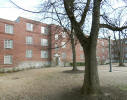 |
In 1935, Memphis became the second city in the nation to
establish a Federal Housing Authority. The first project
was to build two housing projects - Dixie Homes for blacks,
and Lauderdale Courts - for whites. Lauderdale Courts
was Colonial Revival in style with brick exteriors and porches
covered by metal roofs. It became famous because Elvis
Presley and his parents occupied apartment 328 from 1949 to
1953. The complex closed in 2000 but was renovated and
reopened in 2004 as Uptown Square. |
|
|
|
|
|
|
|
|
|
|
|
|
|
|
|
Loeb's Laundry
.
Various locations |
|
|
|
For almost
120 years, the Loeb family has operated businesses in Memphis.
In 1887 Henry Loeb Sr. was in business making and selling hats and
shirts. And then he opened a laundry to launder the shirts.
This market was considerable and he found the business constantly
growing. By 1910 he had expanded the business into a 3-story
plant on Madison Avenue. And then he introduced horse-drawn
delivery service. When Henry Sr. died in 1936, his son William
took over the family business, but only lived another five years.
The business then became a trust for his two sons - Henry and Bill,
with Bill eventually buying out his brother. Bill expanded
the laundry operations, reaching the 500 employee mark in the 1960s
and 70s. He also founded a chain of 100 successful barbeque
restaurants. In the 1980s, Louis and Bob, the fourth
generation of Loeb's took over the family business. |
 |
 |
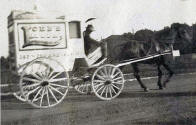 |
 |
|
Loeb's |
Loeb's on
Main -
c. 1903-1907 |
Loeb's
Delivery |
Loeb's
Delivery |
|
|
|
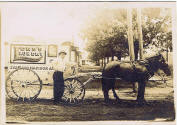 |
 |
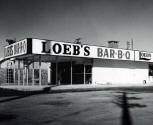 |
 |
|
Loeb's
Delivery |
Loeb's
Receipt - 1902 |
|
Loeb's -
Main |
|
|
|
|
|
|
|
|
|
|
|
Marx-Bensdorf
Realty .
152 Madison
Avenue . 149 Monroe - 42 S. Second |
|
|
 |
 |
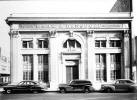 |
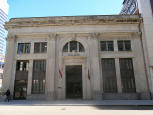 |
|
Marx-Bensdorf . 42 S.
Secnd |
Marx-Bensdorf on Second |
Marx-Bensdorf 42 S.
Second |
Cadre Bldg- 42 S. Second |
|
|
|
|
Marx-Bensdorf was established in 1868 and is the oldest real
estate firm in Memphis. It's also one of the oldest
businesses in the city, having been in continuous operation since
its founding. For many years their main office
was the classic Bensdorf building at 152 Madison, built in 1905. They moved to another classic building built in
1928 at 149 Monroe. The Building on Monroe is now known as The
Cadre Building and is an Events Rental Facility. The
secondary address for this building is 42 S. Second. Former soccer coach Seamus Loftus opened "The Brass Door" - an Irish
pub and restaurant in the old building at 152 Madison.
|
|
|
 |
 |
 |
 |
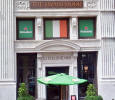 |
|
Cadre - 149 Monroe |
149 Monroe Entrance |
Cadre - Interior |
152 Madison |
152 Madison |
|
|
|
|
|
|
|
|
|
Masonic
Cathedral .
Dunlap and
Union. |
|
|
|
The
Tennessee Consistory #1, Scottish Rite Masonic Cathedral was built
in 1909 at Dunlap and Union. Either the original building was
remodeled or rebuilt because the Masonic Cathedral still standing at
this location is a different design - although it's similar and is
still an impressive structure. |
|
|
|
|
|
|
|
|
|
|
|
|
Masonic Temple
.
Madison and
Second |
|
|
|
The
street corner of Madison and Second is important in Memphis
history. After the Civil War, the Governor convened the
state legislature on this site. The state archives
were also briefly stored here. The cornerstone for the grand
Masonic Temple was set in 1878 amid huge celebrations.
(We discovered an architectural drawing of the ORIGINAL
design of the building in a full page newspaper article during
the cornerstone celebration in 1878. And the full page
article is printed below. It's a HUGE file. Please
be patient while it loads). There
were major setbacks during the actual construction due to two
major Yellow Fever epidemics which led to financial problems.
The Masonic Temple served many purposes in addition to housing
meetings of the Masonic brotherhood. |
 |
| |
Masonic Temple 1890s |
|
|
|
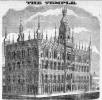 |
 |
In
1910 the grand Masonic Temple was demolished and replaced with
the Germania Bank Building, which was 6 stories, topped
with a penthouse. In the 1950s that building was demolished and
replaced with the Blake Building - one of the worst
in
Memphis history.
What
were they thinking?
>>>> |
 |
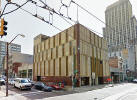 |
|
Original
Drawing |
1878 Article |
|
Germania Bank |
The Blake Bldg. |
|
|
|
|
|
|
|
|
|
|
|
Masonic Temple .
272 Court and
Fourth. |
|
|
|
The
Masonic Temple at Court and Fourth was built in 1914 by
architects Jones and Furbringer. The
Neo-Classical building is still standing. Click on the
1914 Souvenir Book below to see some rare photos of the interior. |
|
|
 |
 |
 |
 |
 |
 |
|
Masonic Temple 1914 |
Masonic Temple Today |
1914 Spoon |
1910 Metal |
1878 Assessment |
1914 Souvenir Book |
|
|
|
|
|
|
|
|
|
|
|
McLellan's .
57 - 61 South
Main |
|
|
|
The McLellan Stores were a chain of five and dime stores
founded by William McLellan in 1917. The chain grew to
200 stores, but the Depression drove the company into
bankruptcy. They merged with McCrory Stores in 1958.
This building, next to the Farnsworth-Three Sisters-Business Journal
building on the corner of Union, still exists (See photos below). We do not know
it's current occupant. |
 |
| |
Mclellans |
|
|
|
|
|
|
|
|
|
|
|
|
|
|
|
|
|
Medical Arts
Building .
240 Madison |
|
|
 |
 |
The Medical Arts Building was erected in 1925-26. The
structure was dedicated to the medical arts with doctor's
offices of all specialties. Eventually the building
became too dated for modern doctors and they moved on to more
modern facilities. In 1952 the ground floor was
remodeled by replacing the terra cotta with slabs of red and
black granite. It was not the most successful
renovation on a really nice Gothic office building. The
building was vacant from 1971, and suffered fire damage in
1993. Now known as the Hickman Building, the
owner plans "to renovate as
apartments-condos". The Medical Arts building was added
to National Register Historic List in 1984. |
|
|
|
|
|
|
|
|
|
|
|
Memphis Steam
Laundry .
941 Jefferson |
|
|
|
The
Memphis Steam Laundry Company goes back to 1882, but they
opened their Jefferson building in 1927. Architect E. L.
Harrison modeled the building after the Doges' Palace in
Venice and the facade was adorned with patterned brickwork,
elaborate arches and terra-cotta ornamentation.
Critics called the building "the best piece of eclectic
architecture the city ever had", and the city loved it.
But when the Medical Center began looking for more space in
the 1960s, the building suddenly became "a monstrosity".
In 1973 the building was demolished - the Medical Center got
their space. |
 |
|
|
|
|
|
|
|
|
|
|
|
Mid-South
Cotton Growers Association .
44 S. Front |
|
|
|
Constructed in 1936, this art-deco building was built for the
Mid-South Cotton Growers Association. The concrete walls
are incised with decorative elements which catch the light in
the design at different times of the day. For many
years, this building was used in the Portland Cement
advertisements as a classic example of the beauty of concrete
construction. Three companies, Easy PC, Bluff City
Finance, and Memphis Finance Co, have recently moved into this
building. |
 |
 |
|
|
|
|
|
|
|
|
|
|
|
Joseph N.
Oliver Building .
99-103 S.
Front |
|
|
|
In
1860 Joseph Oliver came to Memphis to open a hat shop.
The following year the Civil War broke out and he found that
the wholesale grocery business was more profitable.
During the next 40 years he owned numerous warehouses and
storage facilities in the city. In 1904 Oliver built the
Beaux-Arts style Oliver Building as a cold storage facility -
the first of its kind in the South. The walls were
insulated with thick panels of cork and cooled by river water
pumped through a maze of pipes, which were pressurized by a
coal-burning furnace in the basement. Because the grand
edifice with false windows, resembled a theatre, Oliver
decorated the window openings with paintings of fish,
chickens, and other foods that were stored there. Listed
on National Register in 1970. Today,
the building is being "developed". |
 |
|
|
|
| |
|
|
|
 |
| |
|
|
|
Brass Blotter
Cover |
|
|
|
|
|
|
|
|
|
|
|
Piggly Wiggly
Building .
79 Jefferson
Avenue |
|
|
|
Piggly
Wiggly was the first true self-service grocery store, founded in
1916 by Clarence Saunders. Customers entered the store through
turnstiles and walked through 4 aisles to view items sold in
packages and organized into departments. They selected their
own merchandise in baskets or carts and moved to the cashier.
Packaging and brand recognition became important to companies.
The date the building was demolished is not known, but a marker
identifies the spot in downtown Memphis. |
|
|
 |
 |
 |
 |
|
First Piggly Wiggly |
Interior |
Interior |
Original Location |
|
|
|
|
|
|
|
|
|
|
|
Porter
Building .
10 N. Main
Street |
|
|
|
The D. T.
Porter Building was built in 1894 as the Continental National Bank
Building and was the city's first skyscraper. The architech
was Jones, Hain and Kirby. For many years
it was the tallest building in the mid-south. In addition it
had Memphis' first elevator. Folks came from miles around and
paid 10 cents for an elevator ride to the roof the view. D. T.
Porter was a pharmacist who never opened a pharmacy in Memphis - but
he prospered in the wholesale grocery business. He was also
responsible for adopting the water system that cleaned up the city
and prevented further outbreaks of yellow fever. He died in
1898 and left money for his family to use as a memorial. In
1900, his family purchased this office building and renamed it in
his honor. The building was renovated in 1983 and is
condominiums today. It is on the National Register
of Historic Places. |
|
|
 |
 |
 |
 |
 |
| |
|
|
Porter
1900 |
Rate
Interior |
|
|
|
|
|
|
|
|
|
Puck Building
.
409 S. Main |
|
|
|
The Puck
Building is located in the heart of the South Main Historic
District. Built in 1912, the building was designed by Jones
and Furbringer and included Terra Cotta detailing. The
building originally housed the Puck Grocery and Warehouse and it
still carries the "Mid Summers Night Dream" Puck Crest in mint
condition at the roof line. More recently the building was
home to the Jay Etkins Gallery. Today, it has been renovated and
is currently for sale. It was added to the National Register
in 1999. |
|
|
 |
 |
 |
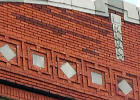 |
 |
|
Puck Bldg |
Puck Bldg |
Puck Building |
Puck - Detail |
Puck -Terra Cotta |
|
|
|
|
|
|
|
|
|
|
|
Queensware
Building
* .
Lawrence
.
Washburn
.
60 South Main
Street |
|
|
This
is an outstanding commercial Romanesque building built in
1881. It originally housed the Lemmon and Gale Wholesale Dry Goods
and was known as the Queensware Building.
This was the largest such store in Memphis for many years.
After that, it seems that the Lawrence Furniture Company occupied
the building forever. In the 1900s, some
very fine China was made by the major china houses of Europe and
marketed as "Memphis Queensware". Today, it is very
collectible. The Queensware building has recently
been renovated for apartments and is now known as the Washburn
Building. Hard to believe that this buiilding is not on the
National Register List??? |
 |
| |
|
|
|
*
Queensware China and the
Queensware Building have their own comprehensive coverage ...
>
Click here |
|
|
|
|
|
|
|
|
Radio Center
Flats .
66 South Main |
|
|
|
Radio Center was built in 1947 as the home of radio station WMPS. Later it became the home of station WDIA.
The building is noted for shaping the popular culture of
Memphis and the country for over 50 years. WMPS was
primarily a country-western station. It also showcased
the early careers of Kay Starr and Eddie Arnold. In 1985
WDIA moved to Radio Center. It was the country's number
one African American radio stations and their most lasting
contribution was the music they played - all black music.
The center has recently been renovated and is now apartments
and condos. It was added to the National Register in
1983. |
 |
|
|
|
|
|
|
|
|
|
Randolph
Building .
Main and Beale
St |
|
|
|
The Randolph building was completed in 1891. At that
time it was Memphis' tallest building. The structure was
built by William M. Randolph, a lawyer from Little Rock.
It was demolished in mid 1970s as part of the Beale Street
renewal project, even though it was on the National Register
of Historic Places. |
| |
|
 |
 |
 |
 |
|
Randolph Building postcard
|
Randolph Bldg. |
Randolph Bldg |
Postcard 1905 |
|
|
|
|
|
|
|
|
|
|
|
|
W. T. Rawleigh
Factory .
Illinois and
Pennsylvania |
|
The W. T. Rawleigh Company of Freeport, Illinois, was one of
the country's largest producers of patent medicines,
cosmetics, insecticides, and spices. They were hugely
successful and are still in business. The Rawleigh
Company opened this factory in Memphis in 1912 and it was the
largest Rawleigh manufacturing plant in the country. The
building is still standing, although it is abandoned. W. T. Rawleigh was noted for
their traveling salesmen who would leave "free trials",
knowing that the products would sell themselves. |
 |
|
|
|
|
*
W.T. Rawleigh Factory
is covered on the Drug and Drug Supply Houses page ... >
Click here |
|
|
|
|
|
|
|
|
|
|
Reichman-Crosby
Building .
60 S. Front Street -
Between Union and Monroe |
|
|
 |
The
Beaux Arts style Reichman-Crosby Building was constructed in
1875 and a new front facade was added about 1910. It was
added to the National Register in 1979. The building has had
numerous owners and after being vacant for some time, the good
news is that, "Memphis in May" has renovated part of the building at
56 S. Front and has recently moved in. |
|
|
|
|
|
|
|
|
|
|
|
|
|
|
|
Restaurants
* |
|
|
|
|
|
*
Restaurants have their
own comprehensive coverage on another section of this website >
Click here |
|
|
|
|
|
|
|
|
|
|
|
Rex Club
Building .
Dunlap and
Madison |
|
|
|
The Rex Cub, dating
from 1861, was a social organization for Jewish men which
eventually developed into the Ridgeway Country Club. The
Rex Club and the Y.M.H.A joined forces to build this structure in
1910. The grand building had a banquet hall, ballroom, bowling alley,
swimming pool, auditorium, seating 400, and a gym. It was also
apparently expensive to maintain because the organizations sold the
building in 1920 to the O. K. Houck Foundation, who made some
modifications to the building. It was sold
again in 1933 to UTMU, who acquired the building for use as their
student center and renamed it University Center. The
structure was demolished in 1969 to build the UT General
Education Building. The 1910 postcard (below)
might be the architect's original plan for the building.
With its rounded corner entrance and arches in the front, It's far more beautiful than the final building. (We're
still
researching this one). |
|
|
 |
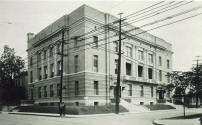 |
 |
 |
 |
|
Rex Club |
Rex Club 1912 |
Rex Club Postcard 1910 |
Rex SOLD |
Rex Club |
|
|
|
|
|
|
|
|
|
|
|
Schools
* |
|
|
|
|
|
|
|
*
Memphis Schools have
their own comprehensive coverage on several sections of this website
>
Click here |
|
|
|
|
|
|
|
|
|
|
|
Scimitar
Building . Madison Avenue Bldg . Memphis Light, Gas and
Water . 179 Madison and
3rd |
|
|
|
The
Scimitar building was built in 1902 by Napoleon Hill, the
"Merchant Prince of Memphis", and was originally
named the "Madison Avenue Building. The architects were
Chigazola and Hanker. The Romanesque structure features
a row of lions and fleur-de-lis running beneath the cornice.
The Memphis Press Scimitar called this building home for many
years and that is the name that's closely associated with the
building now. It is also sometimes known as The Memphis Light,
Gas, and Water Building. The building was added to the
National Register of Historic Places in 1983. The builder,
Napoleon Hill was the richest man in
the city and lived in a most impressive mansion across from
the present day Sterick Building. The building is
being renovated into a boutique hotel named Hotel Napoleon. |
|
|
 |
 |
 |
 |
 |
| |
Madison Building 1902 |
1921 Ad |
1906
Postcard |
Scimitar today |
|
|
|
|
|
|
|
|
|
|
|
|
S. C. Toof
Company .
295 Madison Avenue
- next to AutoZone Park |
|
|
|
Architect G. M. Shaw designed this "Chicago School" style
building for the S. C. Toof & Company in 1913. The
impressive building with Egyptian Revival influences, has terra cotta elements. The Toof
company is the oldest printing company in Memphis, and still
in business as "Toof Commercial Printing". The building
was added to the National Register of Historic Places in 1982.
In the mid 1990s there were plans to establish a minor league
baseball museum in the vacant building, but as of 2008 the
building is still vacant and boarded up. This building
is in danger! |
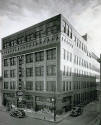 |
|
|
|
 |
 |
 |
 |
 |
 |
|
Building
... today
|
Mural on
side ...today |
1891 Toof
Co. Photo |
1899
Receipt |
Invoice
1941 |
1902 Ad
|
|
|
|
|
|
|
|
|
|
|
|
Sears Building
.
495 N. Watkins |
|
|
|
The grand
opening of Sears Crosstown was in 1927. At that time it was
the South's only Sears, Roebuck and Company catalog order plant.
There were 11 floors and 650,000 square feet of floor space.
It was also a Gothic architectural gem. The building was
expanded over the years, but in 1983 it closed, and the building has
been vacant sine 1996. Today there are broken windows and
rusty fire escapes, but there is a bright future. In 2007, the
property was purchased and the new owner is expected to renovate the
building as a retail facility.
Some of
Memphis' most influential organizations, along with some
high-profile real estate, construction and design professionals, are
now banding together in an effort to reclaim the former glory of the
Sears Crosstown facility. They plan to convert the 1.5 million
square foot building into a multi-tenant commercial property with
850,000 leasable square feet. The mammoth structure's new life
is foreseen as a "vertical urban village" . |
|
|
 |
 |
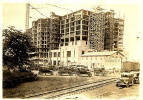 |
 |
 |
 |
|
Sears Crosstown |
F Hemmen |
Sears |
Sears Today |
Escapes |
Sears |
|
|
|
|
Sears - 50 years in
Memphis ... This booklet was
published to celebrate Sear's 50th year in Memphis. Frank
Hemmen, the grandfather of Historic-Memphis.com team member Maureen
Thoni White is on page 10 in the 1937 and the 1947 group photos. |
|
|
|
|
|
|
|
|
|
|
|
|
|
|
Shelby County
Archives .
Hall of Records
.
Washington Av
between 2nd and 3rd Streets |
|
|
|
This
building was originally built in 1924 and housed the Shelby County
Criminal Courts and jail, until 1982. It's built in a
Renaissance style of design. In the "old days" of 1933, the
third floor of the jail was cleared for a single inmate - George
"Machine Gun Kelly" Barnes. In 1968, the third floor was
cleared once again for James Earl Ray, the killer of Martin Luther
King Jr. After the courts and Jail moved in 1982,
the building reopened as the Archives and Hall of Records building. |
|
|
|
|
|
|
|
|
|
|
|
|
|
|
Shelby County Courthouse
.
Adams Avenue
between 2nd and 3rd Streets |
|
|
|
The Shelby
County Courthouse was built between 1906-1909. It was the
first monumental architecture designed for local government by James
Gamble Rodgers, and was meant to rival the buildings of the larger
Northern cities. The opulent building succeeded on all levels.
The neoclassical structure covers an entire city block and features
6 large seated figures - each carved from a single block of
Tennessee marble by John Massey Rhind. The figures represent
Wisdom, Justice, Liberty, Authority, Peace and Prosperity. It
also features a portico supported by a row of 17 large Ionic
columns. Up until 1966 this building housed state and local
courts in addition to the mayor's offices. The Shelby County
Courthouse has been a popular building for several major
movies filmed in Memphis. |
|
|
 |
 |
 |
 |
|
Courthouse |
Entire
Police Force 1940 |
Proposed drawing |
Courtyard |
|
|
|
 |
 |
 |
 |
 |
|
Vintage
Postcard |
1924 BoyScout Troop 6 |
Interior
1910 |
Souvenir
Pitcher |
Souvenir
spoon |
|
| |
|
|
|
|
|
|
|
|
Old Shelby County
Jail
. A. W.
Willis and North Front Street |
|
|
 |
The Old Shelby
County Jail was built in 1868 and demolished in 1935. The
iron fence surrounding the property is all that remains.
Architect James Cook's jail was supposedly escape proof.
It was a double-walled structure with the space between the
walls filled with sand. If an inmate dug through
the wall, sand would flood his cell. As the level of
sand in the walls fell, monitors in the sand would fall,
pulling a wire
that set off an alarm. But it wasn't escape proof after
all, since over 40 prisoners scaled the exterior wall to freedom. |
| |
|
 |
 |
 |
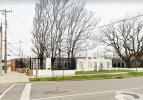 |
| Drawing of the
jail |
Photo |
1912 Back of
Jail - RARE |
Portion of
Fence today |
|
|
|
|
After
a Moonshine raid in 1924, the Press Scimitar posted a photo of
the "raiders" posing in front of the old County jail along with
all the moonshine equipment. |
 |
 |
 |
| |
|
Press Scimitar |
Front of Jail |
Front of Jail |
|
|
|
|
|
|
|
|
|
|
|
|
|
Shrine
Building .
66 Monroe |
|
|
|
The Shrine Building was built in 1923 and was the headquarters
of the fraternal Al Chymia Shrine Temple. Designed by
Hanker & Caims and Jones & Furbringer, the building retains
many of the original architectural features. The lower
eight floors contained professional offices and the temple
itself began on 9th floor. The 2-story arched windows
mark the large auditorium. The Shriner's were forced
move in 1936 when they were unable to meet their mortgage.
In 1976 the building was renovated into apartments and was
added to the National Register list in 1979. |
 |
|
|
|
| |
|
|
|
|
|
 |
 |
 |
 |
 |
 |
| Shrine Bldg. |
Shrine Band
1930 |
Mug 1911 |
1940 Medal |
Key |
1930 Living
Room |
|
|
|
|
|
|
|
|
|
|
|
Sterick
Building .
Madison Av and
3rd Street |
|
|
Designed by Walter Hedrick, this "Queen of Memphis" was the
tallest building in the city until the completion of the tower
at 100 North Main in 1962. Hedrick secured financing
from R. E. Sterling and the name of the building is a
combination of their names. The Gothic-style building
opened in 1930 and had an amazing 8 high-speed elevators.
The building was once fully occupied by a variety of large
corporate tenants, but it began to decline in the 1960s, along
with the rest of downtown. |
 |
 |
| |
|
Paperweight |
| |
|
|
| |
| |
|
|
|
|
|
|
|
|
Sun Studio
Building .
706 Union |
|
|
|
This
remarkable little recording studio literally changed the
world. The first rock 'n roll single was recorded here
in 1951 - and the studio launched the careers of Elvis
Presley, Johnny Cash, Jerry Lee Lewis, Carl Perkins, Roy
Orbison, and many others. The studio was opened by Sam
Phillips in 1950 and the original name was Memphis Recording
Service. Phillips launched his own record label in 1952,
renamed the company Sun Studio and the rest is history.
By 1959 Phillips had moved on and the tiny studio lay vacant
until 1987 when it was renovated as a tourist attraction.
In 2003 it was designated a National Historic Landmark. |
 |
|
|
|
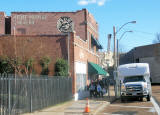 |
 |
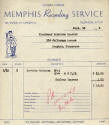 |
 |
 |
|
Sun
Studio |
Sam -
Elvis - 1956 |
Memphis Rec. Invoice 1954 |
Sun
Records Marker |
Taylor's
Restaurant |
|
|
|
|
|
|
|
|
|
|
|
Tennessee
Brewery .
477-495 Tennessee
Street |
|
|
|
This
ornate castle-like structure was built between 1877-1890.
It was originally constructed for the Memphis Brewing Co in
1877. In 1885 it was purchased by the Tennessee Brewing
Co who took advantage of Memphis's pure artesian water which
helped make their beer (Goldcrest) the largest seller in the
South. The brewery was enlarged in 1890 to it's present size.
It closed in 1954 and the building remained vacant for 50 years.
The building was added to the the National Register in 1980.
There have been plans to renovate, but all have fallen apart.
It was recently purchased by developer Billy Orgel and will become
the centerpiece of a $27.5 million residential development that
begins construction in the fall of 2015. |
|
|
 |
 |
 |
 |
 |
|
Tennessee
Brewery |
Tennessee
Brewery |
Delivery
1940 |
Brewery Tray |
Brewery -
Circa 1890 |
|
|
|
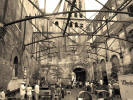 |
 |
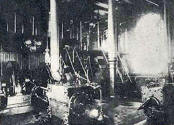 |
 |
 |
|
'Save the
Brewery' |
Courtyard |
2 Ice
Machines |
Bottle |
The Big
"Kettle" |
|
|
|
 |
 |
 |
 |
 |
 |
|
Goldcrest
Beer Cans |
|
Key 1910 |
Labels |
Labels - c. 1933 |
Label 1933 |
|
|
|
| |
|
|
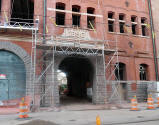 |
 |
| |
|
|
Renovation 2017 |
Renovation
2017 |
|
|
|
|
|
|
|
|
|
Tennessee Club
.
130 N. Court
Avenue |
|
|
 |
This
is one of the most distinctive buildings in Memphis. It
was designed by Edward Terrell and built in 1890 for the
Tennessee Club. The style is a mixture of Victorian,
Romanesque, and Moorish. The Tennessee Club was founded
by a group of men , mostly Confederate Officers, who were
determined to restore social graces to the city after the
Civil War. They established a library and art gallery
and fostered civic and scientific debates. Many social
events were presented in their 4th floor ballroom. In
1970, the building was purchased by the law firm of Burch,
Porter & Johnson, who renovated the building. |
|
|
|
 |
 |
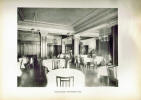 |
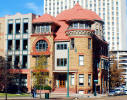 |
 |
|
Tennessee Club 1912 |
TN Club - Interior 1912 |
TN Club Dining Rm |
TN Club today |
TN Club 1953 |
|
|
|
 |
 |
 |
 |
 |
 |
|
Cornerstone |
1898 Envelope |
TN Club Officers |
TN Club Menu Cover 1962 |
Menu |
Menu |
|
|
|
|
|
|
|
|
|
|
|
Tennessee
Trust .
Fidelity Bank & Trust
. The Madison
.
79 Madison |
|
|
|
This 15 story building was constructed in 1906 for the
Tennessee Trust Bank. The Beaux Arts style building was
designed by George Shaw and Charles Phell. It was the first bank on "Banker's
Row" to exceed the traditional 4-story height for banks.
In 1998, it was renovated as the luxury Madison Hotel and was
listed on the National Register in 1982. |
 |
 |
  |
|
|
|
|
|
|
|
|
|
Theatres
* |
|
|
|
|
|
|
|
*
Memphis Theatres have
their own comprehensive coverage on another section of this website
>
Click here |
|
|
|
|
|
|
|
|
|
|
First
Tennessee Trust .
165 Madison |
|
|
 |
There is one more tall structure that stands in downtown
Memphis. The First Tennessee Bank Building is located at 165
Madison Avenue. The office building stands 332 feet high with
25 floors making it Memphis' sixth tallest skyscraper.
Construction of the building was completed in 1964. Currently,
First Tennessee Bank occupies approximately half of the
building. |
|
|
|
|
|
|
|
|
|
|
|
Train
Stations
*
Calhoun, Poplar, Union,
Central, etc. |
|
|
|
|
|
|
|
*
Memphis Train Stations
have comprehensive coverage on another section of this website
>
Click here |
|
|
|
|
|
|
|
|
Union Planters
Bank .
67 Madison |
 |
 |
This
12 story structure was built in 1924 as the headquarters for
the Union Planters Bank. This major financial
institution was founded after the Civil War and was the
largest bank in Memphis. Designed by McKim, Mead and
White, the building was recently
renovated and converted to apartments with the lobby and
mezzanine used for retail space. The building was added
to the National Register in 1979 and was
featured in the 1993 move "The Firm". |
|
|
|
|
|
|
|
|
|
100 N. Main
.
|
|
|
|
Built in 1965, 100 N. Main, at 37 stories, is
the tallest building in Memphis. Designed by Robert L.
Hall, it's a focal point of the city skyline. It's tenant
base consists primarily of attorneys, title companies, and
various other professionals, but in January
2012, only 30% of the building was occupied. For years,
the building was crowned with an illuminated "UP Bank" sign.
The sign was dismantled in 2005 when Union Planters National
Bank was acquired by Regions Bank. When the building opened,
there was a revolving restaurant atop the main roof. This
restaurant operated under several different owners, but is
currently vacant. In their 1986 book architects Eugene J.
Johnson and Robert D. Russell, Jr. called 100 N. Main "one of
the least interesting" downtown structures. |
|
|
 |
 |
 |
 |
 |
|
100 N Main |
Under Construction |
Under Construction |
Restaurant Plate |
Roof Garden |
|
|
|
|
|
|
|
|
|
Van Vleet
Drugs Building * . 109
S. Second
and Gayoso |
|
|
 |
Memphis
was once the leader in the wholesale drug market and took great
pride in being the home to Van Vleet-Mansfield Drug Co., one of the
largest drug firms in the United States. Van Vleet-Mansfield Drug
Co. was located in the heart of Downtown Memphis on the corner
of Second and Gayoso. This building has recently been
renovated into a mixed -use facility with 60 loft apartments and
15,000 sq ft of commercial space. |
|
|
|
|
*
Van Vleet Drugs and
Peter Van Vleet are covered on another section of this website >
Click here |
|
|
|
|
|
|
|
|
|
|
YMCA Building . 245
Madison Av |
|
|
|
The
YMCA was built in 1909. President Howard Taft was a special
guest at its dedication. The impressive structure
features open arches and a row of gargoyles. It was
recently
renovated into the YMCA Lofts which occupy the top 4 floors.
The YMCA remains on the ground floor as a community building-exercise facility. President Barack Obama made a
low-key visit in 2008 when he stopped in for a midnight game of
basketball after the debate in Oxford,
Mississippi. |
|
|
 |
 |
 |
 |
 |
|
|
|
|
Presedent Taft at
the 1909 Dedication |
|
|
|
 |
 |
 |
 |
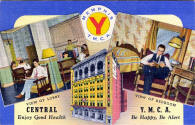 |
|
First YMCA |
YMCA Dance |
YMCA Pool |
YMCA Sundeck |
YMCA Postcard |
|
|
|
|
|
|
|
|
|
|
|
YWCA Building
. 291
South Second |
|
|
|
The
Young Women's Christian Association goes back to 1871.
This building was named the Anne
Brinkley Home in 1892 and served as a
boarding home for young working women and became the Women's
Christian Association's headquarters. The structure was
demolished in 1970. Interesting: In the color and
black and white photos below, the frieze at the top of the building
was removed when the building became the YWCA. |
|
|
|
|
|
|
|
|
|
|
|
|
|
|
|
|
|
Credits |
|
|
|
The
Historic-Memphis website does not intentionally post copyrighted
photos and material without permission or credit.
On
occasion a "non-credited" photo might possibly be posted because we
were unable to find a name to give credit. Because of the nature of
our non-commercial, non-profit, educational website, we strongly
believe that these photos would be considered "Fair Use. We have
certainly made no monetary gain, although those using this website
for historic or Genealogy research have certainly profited. If by
chance,
we have posted your copyrighted photo, please contact us, and we'll
remove it immediately, or we'll add your credit if that's your
choice. In the past, we have found that many photographers
volunteer to have their works included on these pages and we'll
also do that if you contact us with a photo that fits a particular
page. |
|
|
|
The "Historic-Memphis" website would like to acknowledge and thank the
following for their contributions which helped make this website
possible:
Woody
Savage for his many 'on call' photos, Google
Earth, Memphis
Public Library, Memphis University Library, Memphis Law Library,
Memphis Commercial Appeal, Memphis Press Scimitar, Shelby County
Register of Deeds, Memphis City Schools, Memphis Business Men's
Club, Memphis Chamber of Commerce, Memphis City Park Commission,
Memphis Film Commission, Carnival Memphis, Memphis Historical
Railroad Page, Memphis Heritage Inc, Beale Street Historic District,
Cobblestone Historic District, Memphis Historic Districts, Vance
Lauderdale Family Archives, Tennessee State Archives, Library of
Congress, Kemmons Wilson Family, Richard S. Brashier, Lee Askew,
George Whitworth, Woody Savage and many individuals whose assistance is
acknowledged on the pages of their contributions. Special
thanks to Memphis Realtor, Joe Spake, for giving us carte blanche
access to his outstanding collection of contemporary Memphis photos.
We do not have high definition copies of the photos on these
pages. If anyone wishes to secure high definition photos,
you'll have to contact the photographer or the collector.
(To avoid any possibility of contributing to SPAM, we do not
maintain a file of email addresses for anyone who contacts us). |
|
|
|
|
|
|
|
|
|
|
|
|
|
|
|
|
|
|
|
|
|
|